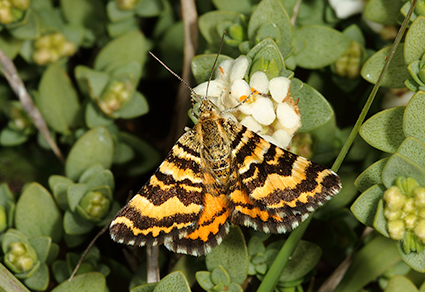Abstract
The endemic Notoreas perornata (Walker, 1863) complex (Lepidoptera: Geometridae: Larentiinae) from the North Island and northern South Island of New Zealand is reviewed. Larvae feed on Pimelea spp. (Thymelaeaceae), frequently in highly fragmented and threatened shrubland habitats. Allopatric populations tend to differ in size and wing pattern characteristics, but not in genitalia; moreover extensive variation renders recognition of subspecies / allopatric species based on any species concept problematic. A mitochondrial DNA gene tree is not congruent with morphology and indicates rapid recent divergence that has not ‘settled’ into diagnosable lineages. Based on our results, we synonymise Notoreas simplex Hudson, 1898 with N. perornata (Walker, 1863), and retain N. perornata as a single, highly diverse but monotypic species. All known populations are illustrated to display variation. For conservation purposes, we recommend the continued recognition within the species of 10 populations or groups of populations that appear to be on the way to diverging at subspecific level based on morphological and/or DNA data. The conservation status of all these populations is reviewed. One conservation unit, comprising the populations from Westland, has not been seen since 1998 and is feared possibly extinct.
References
- Braby, M.F., Eastwood, R. & Murray, N. (2012) The subspecies concept in butterflies: has its application in taxonomy and conservation biology outlived its usefulness? Biological Journal of the Linnean Society, 106, 699–716. https://doi.org/10.1111/j.1095-8312.2012.01909.x
- Craw, R.C. (1986) Review of the genus Notoreas (sensu auctorum) (Lepidoptera: Geometridae: Larentiinae). New Zealand Journal of Zoology, 13, 131–140. https://doi.org/10.1080/03014223.1986.10422654
- Crosby, T.K., Dugdale, J.S. & Watt, J.C. (1998) Area codes for recording specimen localities in the New Zealand subregion. New Zealand Journal of Zoology, 25, 175–183. https://doi.org/10.1080/03014223.1998.9518148
- Dugdale, J.S. (2001) Cloudy Bay Coastal Habitats: Entomological Values of the Foreshore and Associated Habitats. Department of Conservation Occasional Publications, 49, 1–28.
- Folmer, O., Black, M., Hoeh, W., Lutz, R. & Vrijenhoek, R. (1994) DNA primers for amplification of mitochondrial cytochrome c oxidase subunit I from diverse metazoan invertebrates. Molecular Marine Biology and Biotechnology, 3 (5), 294–299.
- Hoare, R.J.B., Dugdale, J.S., Edwards, E.D., Gibbs, G.W., Patrick, B.H., Hitchmough, R.A. & Rolfe, J.R. (2017) Conservation status of New Zealand butterflies and moths (Lepidoptera), 2015. New Zealand Threat Classification Series 20. Department of Conservation, 13 pp. Available from: https://www.doc.govt.nz/globalassets/documents/science-and-technical/nztcs20entire.pdf (accessed 25 August 2023)
- Hudson, G.V. (1939) A Supplement to the Butterflies and Moths of New Zealand. Ferguson & Osborn Ltd., Wellington, pp. 387–481, pls. 53–62.
- Kearse, M., Moir, R., Wilson, A., Stones-Havas, S., Cheung, M., Sturrock, S., Buxton, S., Cooper, A., Markowitz, S., Duran, C., Thierer, T., Ashton, B., Meintjes, P. & Drummond, A. (2012) Geneious Basic: an integrated and extendable desktop software platform for the organization and analysis of sequence data. Bioinformatics, 28 (12), 1647–1649. https://doi.org/10.1093/bioinformatics/bts199
- Mutanen, M., Hausmann, A., Hebert, P.D.N., Landry, J.-F., de Waard, J.R. & Huemer, P. (2012) Allopatry as a Gordian knot for taxonomists: patterns of DNA barcode divergence in arctic-alpine Lepidoptera. PLoS ONE, 7 (10), e47214. https://doi.org/10.1371/journal.pone.0047214
- Patrick, B.H. (1994) Lepidoptera of Kaitorete Spit, Canterbury. New Zealand Entomologist, 17, 52–63. https://doi.org/10.1080/00779962.1994.9721985
- Patrick, B.H., Hoare, R.J.B. & Rhode, B.E. (2010) Taxonomy and conservation of allopatric moth populations: a revisionary study of the Notoreas perornata Walker complex (Lepidoptera: Geometridae: Larentiinae) with special reference to southern New Zealand. New Zealand Journal of Zoology, 37 (4), 257–283. https://doi.org/10.1080/03014223.2010.511127
- Philpott, A. (1928) Notes and descriptions of New Zealand Lepidoptera. Transactions and Proceedings of the New Zealand Institute, 58, 359–370.
- Platt, A.R., Woodhall, R.W. & George, A. (2007) Improved DNA sequencing quality and efficiency using an optimized fast cycle sequencing protocol. BioTechniques, 43 (1), 58. https://doi.org/10.2144/000112499
- Sinclair, L. (2002) Distribution and conservation requirements of Notoreas sp., an unnamed Geometrid moth on the Taranaki coast, North Island, New Zealand. New Zealand Journal of Zoology, 29 (4), 311–322. https://doi.org/10.1080/03014223.2002.9518315
- Wilson, E.O. & Brown, W.L. (1953) The subspecies concept and its taxonomic application. Systematic Biology, 2 (3), 97–111. https://doi.org/10.2307/2411818


